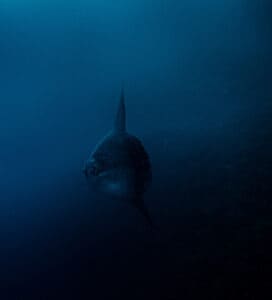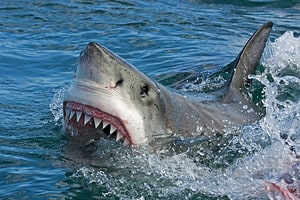Halibut is a sought-after deep sea game fish with lots of fight and a colossal size range. Some of the largest can make 15 feet long! Let’s discover the largest halibut ever caught in Massachusetts, plus the largest halibut world record, and more about this giant-sized fish.
The Largest Halibut Ever Caught in Massachusetts
The largest halibut ever caught in Massachusetts weighed 321 pounds. Norman Cournoyer hooked this water goliath in Massachusetts Bay on 7/21/1965!
Its epic weight makes it the eighth-largest fish ever caught in Massachusetts.
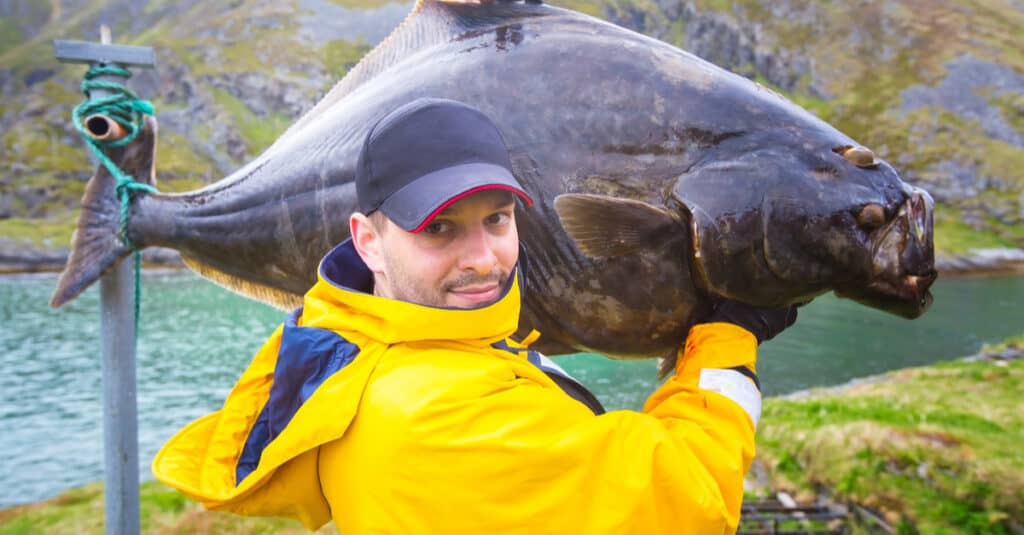
Atlantic halibut can reach 15 feet long, but their size has dwindled over the past few decades.
©Alexey Savchuk/Shutterstock.com
The Largest Halibut Ever Caught
According to the International Game Fishing Association (IGFA), the largest Pacific halibut ever caught weighed an incredible 459 pounds. Jack Tragis hooked this whopper in Dutch Harbor, Alaska, in 1996 and it made him the all-tackle world record holder for halibut. When you consider a fully grown adult reindeer can weigh 400 pounds, that’s quite a fish!
The largest Atlantic halibut ever caught weighed an unbelievable 615 pounds. According to the National Oceanic and Atmospheric Association (NOAA), it was hooked off Cape Ann, Massachusetts, by a commercial vessel. The unfortunate fish was disemboweled before it was brought aboard, but estimates suggest when alive, it may have even weighed 700 pounds.
Even though NOAA’s Atlantic halibut is larger, it’s an unofficial record. The International Game and Fish Association didn’t record this catch, so Jack Tragis’ sport fishing halibut holds the species world record.
Largest Fish Ever Caught in Massachusetts
The largest halibut ever caught in Massachusetts is the eighth largest fish caught there, but it’s pretty gigantic, so what on earth could top it?
If you thought shark, you’re in business. The largest fish ever caught in Massachusetts was a goliath, a 1,324-pound shortfin mako. Kevin Scola caught this scale-breaking shark on July 27, 1999, in Massachusetts Bay.
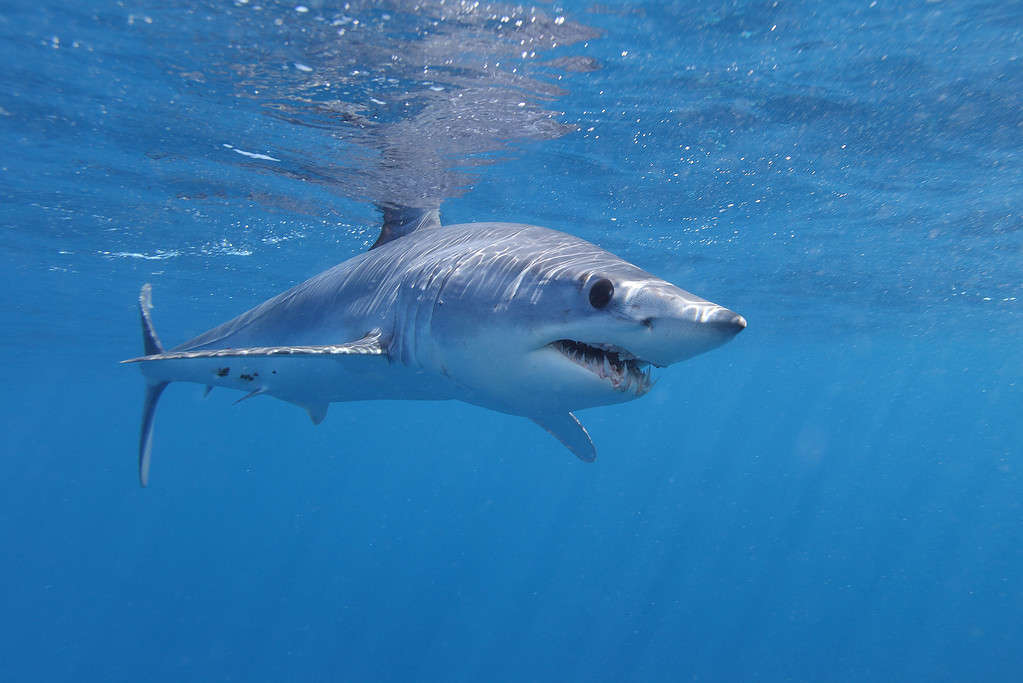
A shortfin mako shark was the largest fish ever caught in Massachusetts.
©Alessandro De Maddalena/ via Getty Images
In second place, and not far behind in terms of weight, is a massive bluefin tuna. Marlene Goldstein caught this 1,228-pound whopper in 1984 in Cape Cod Bay.
And the third largest fish ever caught in Massachusetts?
That’s a blue marlin weighing in at 837 pounds. Dr. Ralph DelaTorre hooked it in 2015.
Massachusetts 321 pound halibut state record sounds lightweight in comparison, but it’s a pretty large fish. Neighboring Maine’s record halibut is a smaller 257-pounder.
Do I Need a License to Fish in the Ocean in Massachusetts?
Yes, anglers need a license to fish rivers, lakes, and the Atlantic Ocean in Massachusetts. Anglers over the age of 16 can buy a permit online.
Pretty hefty fines are handed out to anglers without a permit, so it’s not worth the risk.
Massachusetts Fishing Regulations
If you’re looking to hook a whopping halibut, be sure to stick to Massachusetts’ rules and regulations, or the record won’t count.
- Size Limit: at least 41 inches
- Season: All year round
- Possession limit: 1
If you hook a prohibited fish such as a sand tiger, bignose, or even a shortfin mako, it has to go back. Possessing one of these prohibited fish negates all other catches. Instead, expect a large fine.
Halibut: Species Overview
Halibut are cold saltwater flatfish that reach an average of 20 to 40 pounds and a few feet in length, but given time, they can reach an epic 15 feet long and, as we’ve seen, hundreds of pounds in weight.
Pacific halibut (Hippoglossus stenolepis) lives in the Pacific Ocean in the Bering Sea, Gulf of Alaska, and central California. In contrast, Atlantic halibut (Hippoglossus hippoglossus) lives in the Atlantic Ocean, from the Bay of Biscay to Greenland.
In general, Pacific halibut reach larger sizes than their Atlantic cousins, and they’re often referred to as “barn doors.” On average, epic Pacific halibut reaches eight feet long and five feet wide, whereas Atlantic halibut chiefly reaches four to five feet long.
The Greenland halibut (Reinhardtius hippoglossoides) is also found in the North Atlantic and the Arctic Ocean. This halibut’s home range is from Canada to Norway. Greenland halibut has a straight lateral line as opposed to the Atlantic halibut’s arched line, making it easy to differentiate.
Appearance
Halibuts resemble a broad, flat circle. Their coloring ranges from green to brown on their upper sides and white beneath. This helps them camouflage against predators. Those looking up are dazzled by a white belly against the light, but those looking down only see murky brown-green, much like the ocean depths.
A halibut’s mouth is located beneath its body, and its eyes are pretty strange! Both eyes sit on the right side of their head so they can simultaneously look down at the sea floor and up at the surface. Due to this usual feature, halibut and other similar flatfish species are called “right-eyed flounders.”
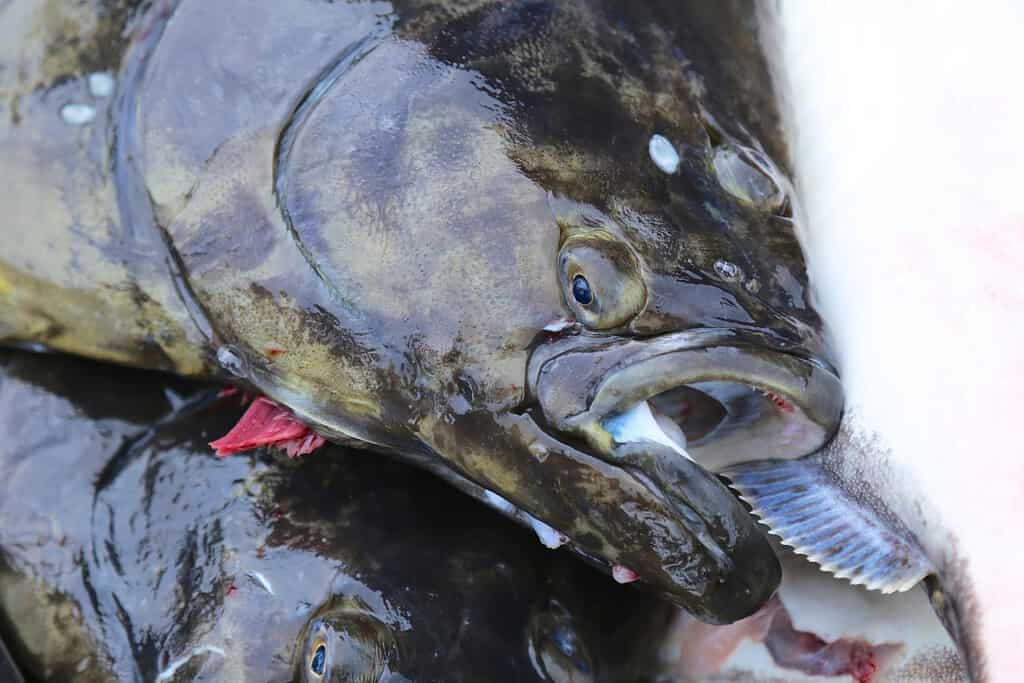
Halibut are right-eyed flat fish. Both eyes sit on the right side of their face.
©CSNafzger/Shutterstock.com
Diet
Squid, crustaceans, octopus, and fish such as ground-dwelling cod or haddock and even smaller halibut create most of this huge flat fish’s diet. Aggressive eaters, they have long, curved teeth that take a bite from most living creatures.
The Official Website of the Commonwealth of Massachusetts reports halibut near the surface, preying on seabirds!
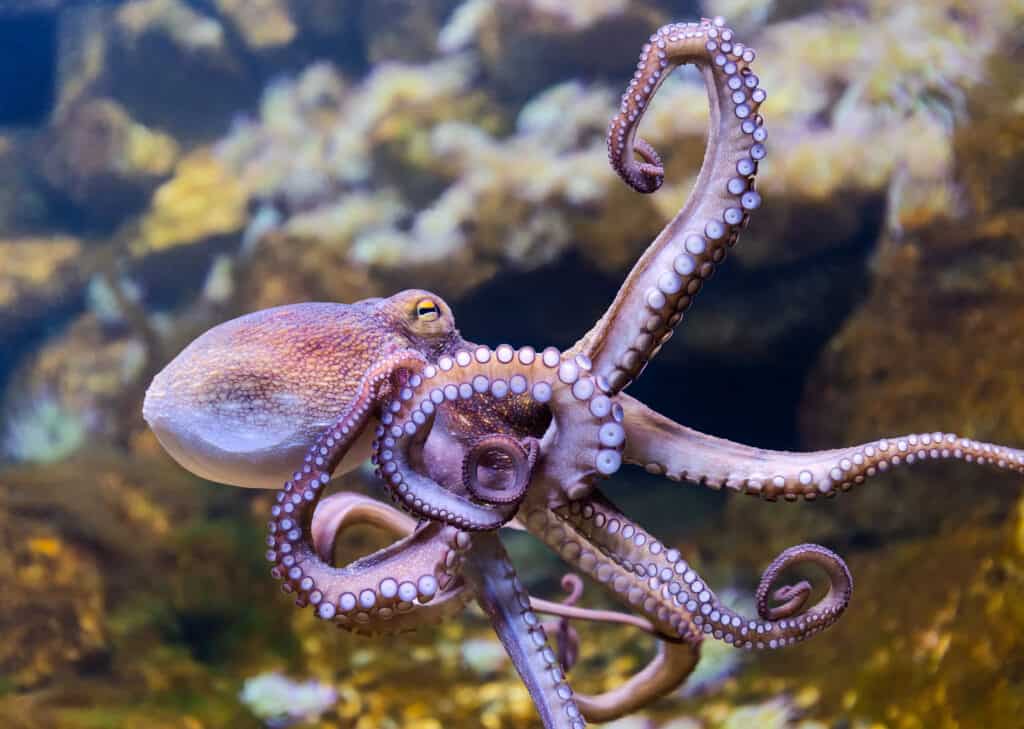
Halibuts eat squid, crustaceans, and octopus from the sea bed. They have sharp curved teeth!
©Henner Damke/Shutterstock.com
Overfishing
Halibut fishing is regulated for sustainability because they were overfished in the past. In Massachusetts, the bag limit is just one because Atlantic halibut is now an endangered species.
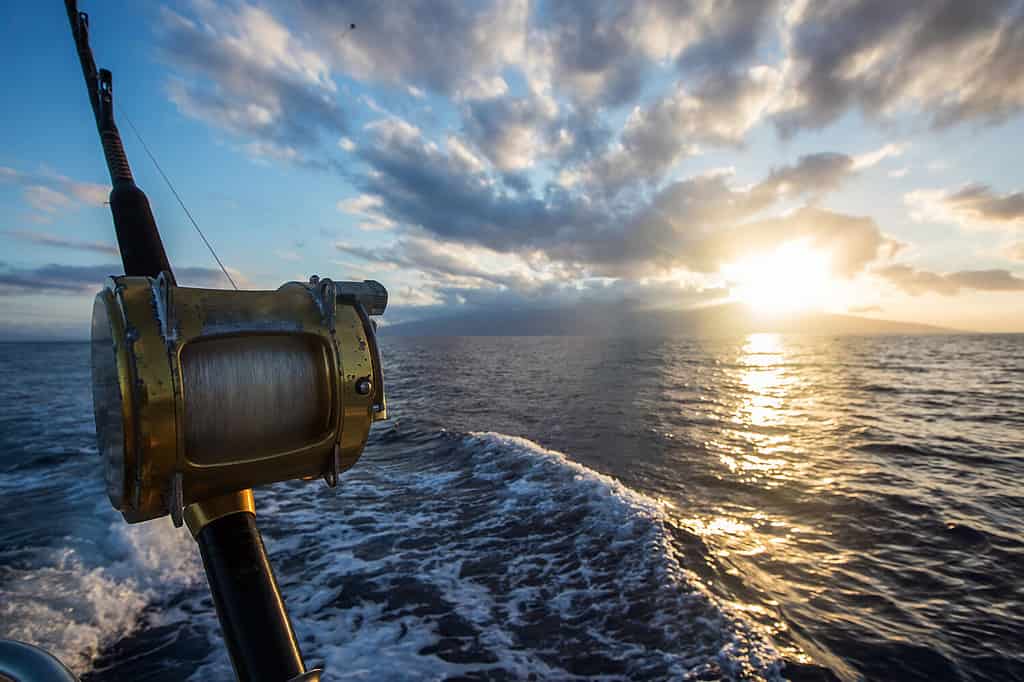
In Massachusetts the halibut bag limit is just one over 41 inches long.
©MPH Photos/Shutterstock.com
Habitats
Halibuts take advantage of shallow coastal waters and deep ocean trenches. Pacific and Atlantic halibuts are bottom dwellers that search through gravelly, sandy, muddy, or rocky sea bottoms for prey.
Predators
Massive adult halibuts have very few predators other than sharks, large dogfish, and marine animals such as seals and whales, but most predator fish, including adult halibuts, eat juveniles.
Where to Find Halibut in Massachusetts
Want to catch a giant flatfish and bust the Massachusetts record?
Let’s prepare.
Halibuts tend to live on the edges of underwater canyons and around structures that offer protection against predators. The best way to locate them is deep-sea fishing on a chartered boat. One of the best places in Massachusetts is Fippenies Edge, which is 65 nautical miles east of Gloucester. This halibut haven is closed to commercial fishing.
Most halibut hopefuls fish with heavy tackle, drift fishing on the bottom of the ocean, but trolling and light tackle fishing can work well, too.
A top tip successful anglers recommended is DO NOT pull directly up. These bottom dwellers are tough; they are hard to get off the seabed, and yanking directly upwards just loses the line. Instead, change your angle or stop pulling until the fish starts to move.
Best Bait for Atlantic Halibut
Successful ‘buters suggest clams, shellfish, octopus, squid, or oily fish like mackerel or herring that smell good to halibut.
Deep drop jibs, pipe jigs, swim jigs, and heavy jigs do the job, too.
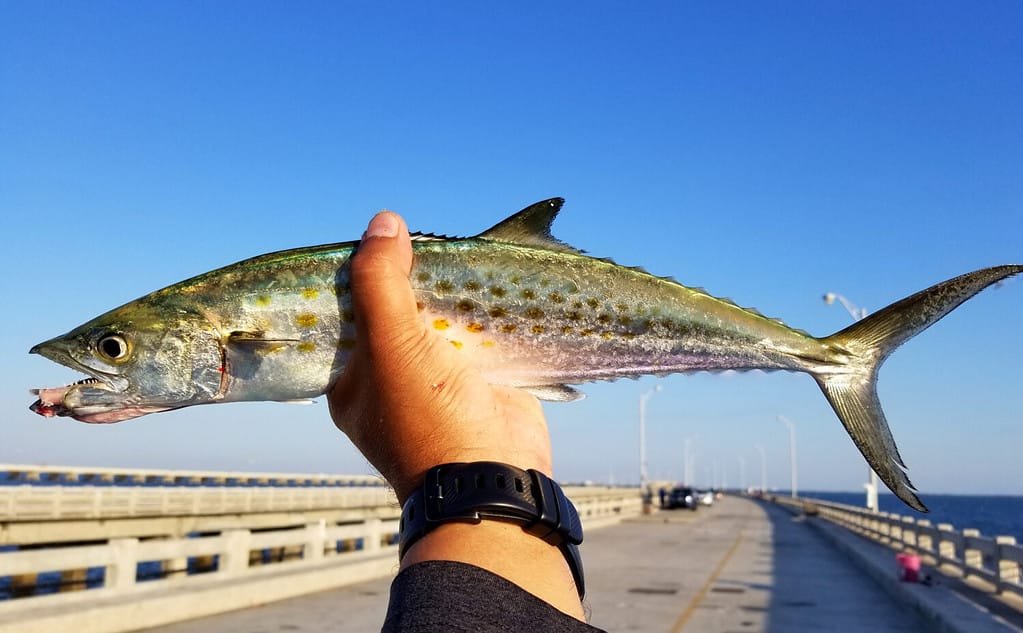
Mackerel is a good bait fish for deep sea halibut fishing.
©Khairil Azhar Junos/Shutterstock.com
Similar Fish
Halibut is often confused with flounder. They do look similar because they’re flatfish with both eyes on one side of their head, but halibut and flounder are different species.
Overall, flounders are smaller flatfish than halibuts; they chiefly weigh one to 20 pounds and reach two or three feet long. Another difference is eye location. Halibut eyes are on the right, whereas flounders are usually on the left. Plus, flounders don’t live as deeply as halibut. A flat fish hooked at 100 -500 feet is more likely to be a flounder than 600-1,200 foot deep-sea dwelling halibuts.
Recap on Massachusetts Largest Ever Halibut
The largest halibut ever caught in Massachusetts weighed 321 pounds. This epic-sized halibut lived in Massachusetts Bay until Norman Cournoyer hooked in all the way back in 1965.
Some Massachusetts anglers suggest that overfishing Atlantic halibut has harmed the quantity and size that sports anglers can expect to hook, but that doesn’t stop them from trying.
The photo featured at the top of this post is © Jon C. Beverly/Shutterstock.com
Thank you for reading! Have some feedback for us? Contact the AZ Animals editorial team.



